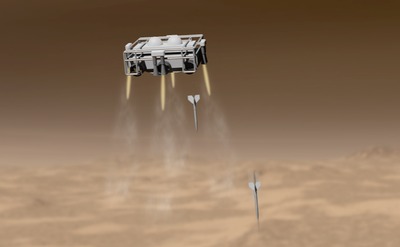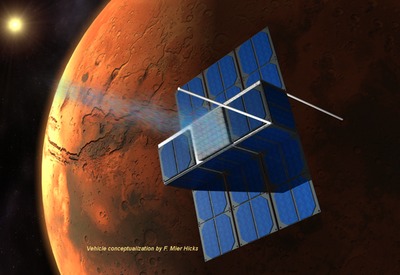Mars missions on the cheapby Jeff Foust
|
| “We decided we’re going to build the first student-led—student-designed, student-inspired, student-funded—CubeSat mission to Mars,” Briere said. |
There are exceptions to the rule, such as India’s first Mars mission, the unimaginatively-named Mars Orbiter Mission, or MOM. Cost estimates for MOM in the media have been about $75 million, which makes the mission look like a bargain compared to MAVEN. However, those cost estimates often fail to point out stark differences between the two, including the different scientific payloads of the two missions and the lower cost structures in India versus the US. Still, it indicates that it’s possible to do Mars missions for less than a typical NASA mission. But how low can you go?
Two projects presented at last month’s Humans to Mars Summit in Washington proposed very inexpensive missions to Mars, leveraging advantages in technology and mission designs. Neither mission is designed to replace those more expensive—and more capable—NASA missions, but instead complement them in the realms of both science and public outreach.
Time Capsule to Mars
The idea for the Time Capsule to Mars mission had its genesis in last year’s Humans to Mars Summit. “A couple of us were sitting in this room, watching the presentations, and getting really inspired by what people were talking about,” recalled Emily Briere, a Duke University student who serves as the project’s mission director. “We were also thinking that there’s got to be a way to inspire that Apollo-era patriotism, but in this new lens of globalism: the same excitement and inspiration on behalf of mankind, instead of just your country.”
They sought a project that could provide that broad interest, while also advancing technology, yet still be something that could be done by a student-led project. “We decided we’re going to build the first student-led—student-designed, student-inspired, student-funded—CubeSat mission to Mars,” she said. In fact, the mission has the potential to be the first CubeSat-class spacecraft built by anyone, not just students, sent to Mars.
As the project’s name suggests, the purpose of the mission is to send a time capsule, in the form of text, photos, and video, to Mars. The spacecraft would travel to Mars and enter the atmosphere, with the time capsule itself surviving reentry to land on the surface. Briere said the project is studying a couple of different designs for the time capsule. One involves “microinscribing” the data on tungsten sheets only a few microns thick that would survive reentry. The other option is to place the data in a metal ball surrounded by an aerogel shell that would ablate during reentry.
One of the technical innovations needed for the mission is the spacecraft’s propulsion system. The mission is planning to use an electric propulsion concept under development at MIT called ion electrospray propulsion. This is a compact form of electric propulsion that requires much less mass, volume, and power than the ion engines and Hall thrusters used today on larger spacecraft. The thrusters make use of some of the same manufacturing techniques as microelectronics in order to produce its microscopic ion-emitting structures.
The result is a system that has the same high efficiencies as larger electric propulsion systems (a specific impulse of about 3,000 seconds) but in a form factor as small as 10 by 10 by 2.5 millimeters. Its current design generates about 25 micronewtons of thrust per square centimeter of thruster area, said MIT professor Paulo Lozano at the Space Tech Expo conference in Long Beach, California, last month. “It’s about three times lower than a convention ion engine,” he acknowledged. “However, we have much better thrust per unit weight and per unit volume.”
Such thrusters can provide CubeSats with attitude control and stationkeeping capabilities these small spacecraft typically lack today. However, he said there’s a lot of interest in using this propulsion technology for interplanetary missions. A basic “1U” CubeSat, which weighs about 1 kilogram, could achieve escape velocity from Earth orbit using this propulsion technology and less than 150 grams of propellant.
| “The whole purpose of our mission is to renew the inspirations of an old generation and introduce our new generation to the excitement of space exploration,” Briere said. |
In the distributed organization model of the Time Capsule to Mars mission, MIT has the lead on developing the propulsion system for the spacecraft. Briere said additional teams focused on marketing and technical issues are based at Duke and the University of Connecticut, while groups at Stanford University and the University of California Santa Cruz are just joining the project. “The idea is that each team would be given a component of the mission—avionics, propulsion, communications—to really focus on,” she said.
Briere said the current cost of the mission is estimated to be $25 million, which covers the assembly and launch of three identical CubeSats. The project is seeking both corporate and individual donations, as well as a crowdfunding model where people pay to place their contributions into the mission’s time capsule. “There are a lot of creative fundraising opportunities that we’re exploring at this point,” she said.
She emphasized, though, that the primary purpose of the mission is public engagement. “We want to make sure that, over the course of three to five years, we have people actively engaged and excited about our project,” she said. “The whole purpose of our mission is to renew the inspirations of an old generation and introduce our new generation to the excitement of space exploration.”
 An illustration of a “Quiver” of Exolance probes deploying from a Mars lander mission. The probes would penetrate up to two meters below the surface to allow their instruments to search for evidence of subsurface life. (credit: Explore Mars) |
Exolance
A day after Time Capsule to Mars presented its plans for a CubeSat-class mission to Mars, Explore Mars, the organization that ran the conference, presented its own ideas for a low-cost Mars mission called Exolance, one that could hitch a ride on other missions to the Red Planet in an effort to look for evidence of subsurface life.
“The goal is to come up with a way to investigate life on Mars,” said Joe Cassady, executive director for space at Aerojet Rocketdyne’s Washington DC office and a member of the Explore Mars management team. “It’s important, we think, to be able to do this repeatably, sustainably, and affordably.”
| “The goal is to come up with a way to investigate life on Mars,” said Cassady of the Exolance concept. “It’s important, we think, to be able to do this repeatably, sustainably, and affordably.” |
The Exolance concept is a penetrator probe that would fly to Mars as a secondary payload on a future Mars lander mission. The primary mission would carry a set, or “Quiver,” of penetrators, each of which weighing only a few kilograms. The penetrators would separate as the main spacecraft entered the Martian atmosphere, passively falling to the Martian surface. “We just take advantage of that kinetic energy we got when we pop off of the main craft and we go bury ourselves into Mars,” Cassady said.
The penetrators would make use of technology originally developed at Aerojet Rocketdyne for “bunker buster” munitions, which are designed to burrow under the surface before exploding. In this case, the explosive payload would be replaced by a scientific one; specifically, a metabolic test that would attempt to detect chemical reactions created by any organisms living one to two meters below the surface. (The Exolance team includes Gil Levin, a scientist involved in the Viking landers who believes, unlike most of the rest of the scientific community, that those missions did detect evidence of life.) Part of the penetrator would remain on the surface, connected to the buried probe by a cable, to provide a communications link to orbiting satellites.
The idea of a penetrator mission to Mars is not a new one. NASA’s Deep Space Two mission in 1999 flew a pair of penetrators to Mars as secondary payloads on the Mars Polar Lander mission. However, like the ill-fated lander, NASA failed to hear from either Deep Space Two penetrator after landing, and an investigation failed to determine a most likely cause of the mission’s failure.
Exolance is still in the early conceptual stages, and the project’s current focus is to perform testing on the penetrator technology itself. “Our goal this year is to raise funds to be able to build and test these penetrators,” said Chris Carberry, executive director of Explore Mars. He estimated the cost to build prototypes and test them in the Mojave Desert to be less than a half-million dollars. “This is something we can do fairly quickly, fairly inexpensively, and have results to prove out the technology and the concept.”
Carberry and Cassady acknowledged that Exolance may not prove to be feasible, but it’s worth at least exploring the concept, given the potential scientific benefits it could provide at a low price. “We really hope we can get people excited about it, and get some other good ideas to come in as well,” Cassady said.
